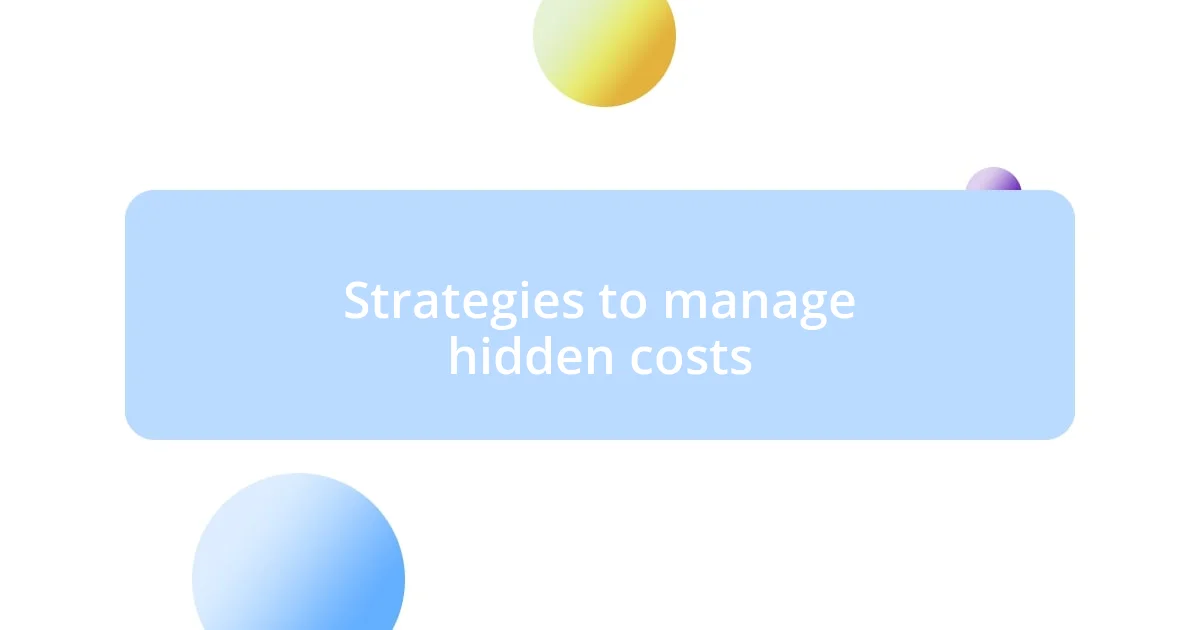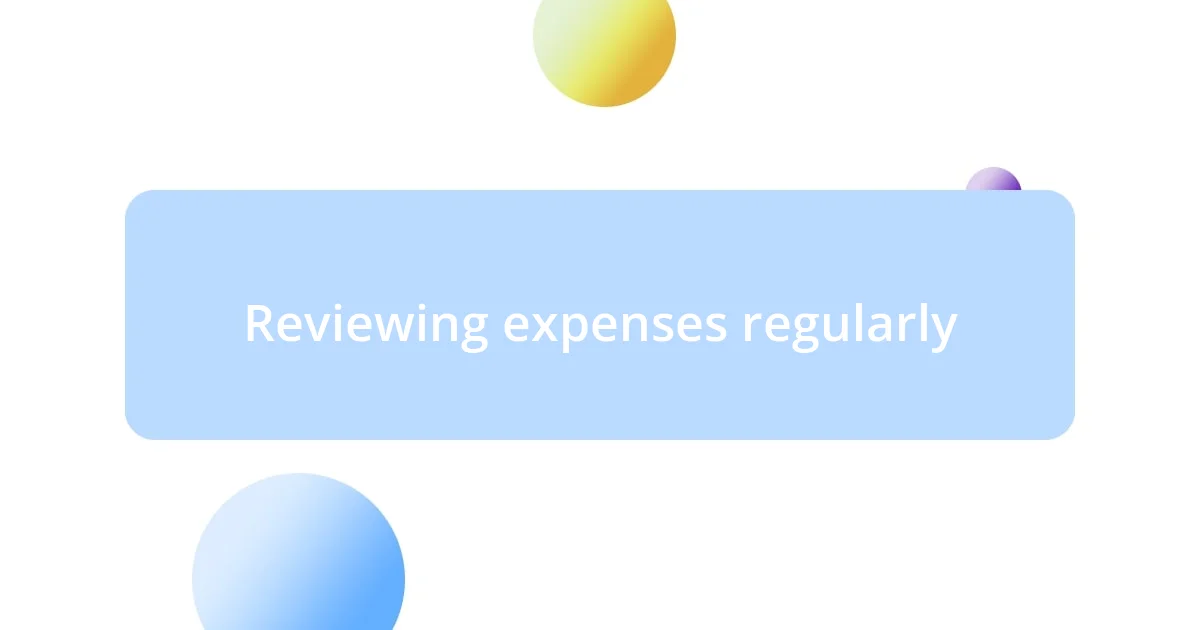Key takeaways:
- Hidden costs can significantly increase expenses, often due to overlooked fees like service charges and insurance premiums.
- Effective expense tracking and budget management help identify and reduce hidden costs, with tools like budgeting apps and spreadsheets proving useful.
- Regularly reviewing expenses can reveal unnecessary subscriptions and inspire positive changes in spending habits.

Understanding hidden costs
Hidden costs can often catch us off guard, lurking in the shadows of a seemingly straightforward transaction. I remember purchasing a brand-new smartphone, excited about its features, only to discover later that the service plan came with unexpected activation fees. Have you ever felt that sinking feeling when you realize what you thought was a great deal is actually more complicated?
When we think of costs, we usually focus on the obvious expenses, but hidden costs can quickly add up. For instance, financing a new car may seem manageable, but those interest rates could inflate the final price beyond what you initially anticipated. I’ve often found myself wondering how easily we overlook these details—could it be a matter of denial, or simply a rush to make a purchase?
Understanding hidden costs requires a bit of diligence and an eye for detail. I once signed up for a subscription service, believing I could easily cancel it if I changed my mind. However, I learned the hard way that there were cancellation fees buried in the fine print. Reflecting on this, I now ask myself: how often do we truly read the terms and conditions? Being aware of these potential traps can transform our approach to spending.

Identifying common hidden costs
Identifying common hidden costs requires a diligent eye and a bit of forethought. I vividly recall purchasing tickets for a concert that seemed reasonably priced at first. It wasn’t until I checked out that the service fees and parking charges nearly doubled the cost. This experience taught me that even small expenses can quickly spiral into large sums if we’re not careful.
Here are some frequent hidden costs to keep an eye out for:
- Shipping and handling fees: Online shopping often adds extra costs at checkout.
- Service or activation fees: These can pop up in various transactions, like utilities or subscriptions.
- Insurance premiums: When financing a purchase, like a vehicle, it’s easy to underestimate these ongoing costs.
- Maintenance fees: This can apply to everything from appliances to vehicles—often buried in the fine print.
- Late or missed payment penalties: A slip in timing can lead to unexpected, frustrating charges.
By sharing my experience, I hope you can learn from my oversight and be more vigilant in your purchasing decisions.

Tools for tracking expenses
Tracking expenses can be a game-changer when it comes to managing hidden costs effectively. I personally rely on both apps and spreadsheets to monitor my spending habits. For instance, using a budgeting app not only keeps my expenses organized but also alerts me to patterns where I might be overspending. Have you ever found yourself questioning where all your money goes at the end of the month? It can be eye-opening to see those categories laid out clearly.
One of the best tools I’ve discovered for tracking my expenses is a simple spreadsheet. With just a few columns and rows, I can categorize my spending, whether it’s groceries, entertainment, or unexpected fees. The beauty of this method lies in its flexibility—if I notice a recurring fee that didn’t make the budget, I can quickly adjust and plan for it. I recall a time when I noticed a monthly charge for an app I rarely used, which prompted me to cancel it. That saved me significant cash over the year!
Ultimately, the right tool for tracking expenses depends on personal preference. Some may favor the automation of apps, while others appreciate the hands-on approach of a spreadsheet. Have you found a method that resonates with you? It’s all about finding what works best for your lifestyle and needs—after all, staying informed can help you dodge those pesky hidden costs.
| Tool | Pros |
|---|---|
| Budgeting App | Convenience and automation, real-time tracking, alerts for overspending |
| Spreadsheet | Customizable, manually track trends, easy categorization |

Strategies to manage hidden costs
Managing hidden costs requires a strategic approach that I’ve found incredibly effective. One tactic I employ is to create a dedicated buffer in my budget specifically for unexpected expenses. I try to set aside a small percentage each month—it feels a bit like saving for a rainy day. Have you ever been caught off guard by an expense? This way, when those hidden costs appear, I can handle them without disrupting my financial flow.
Another strategy I’ve adopted is to read reviews and seek recommendations before making significant purchases. I remember planning to sign up for an online subscription service, but a quick search uncovered users frequently mentioning hidden fees in their reviews. That discovery not only saved me money but also helped me choose a more transparent alternative. It’s all about doing a little homework, wouldn’t you agree? By being proactive, I can sidestep potential pitfalls in the first place.
Lastly, I’ve found great value in periodically reassessing my regular subscriptions and services. It’s easy to forget about that gym membership or streaming service trial that quietly turns into a monthly expense. I make it a point to review these charges every few months. Last year, I realized I was still paying for a magazine subscription I never used. Cancelling it felt like a small victory! It’s a straightforward yet powerful way that I ensure I’m only spending on what truly adds value to my life.

Negotiating to reduce hidden costs
When negotiating to reduce hidden costs, my approach leans heavily on clear communication and awareness of my needs. For instance, I once found myself in a conversation with my internet provider about my monthly bill. I mentioned how I felt the plan didn’t align with my actual usage—this simple honesty led them to offer me a special rate that saved me about $10 each month. Have you ever realized that just asking can lead to surprising outcomes?
I also believe in doing my homework before entering negotiations. Before discussing terms for a gym membership, I scoured the web for comparable prices and promotions. Armed with this information, I confidently approached the manager and asked if they could match a competitor’s offer. To my delight, not only did they honor my request, but they also threw in a few personal training sessions. It was a win-win because I felt valued as a customer and saved money in the process.
Moreover, I embrace the power of timing in negotiations. For example, when I was renewing my phone contract, I chose to engage with the service provider right before a holiday season. They were eager to retain existing customers and offered several discounts and perks that wouldn’t have been available otherwise. Timing your inquiries strategically can really pay off—have you ever thought about the timing of your discussions?

Reviewing expenses regularly
One of my key habits is to regularly review my expenses, and honestly, it’s been a game changer for my finances. I set aside just an hour each month to comb through my statements. It’s not just about money; it’s a glimpse into my spending habits and priorities. Have you ever noticed expenses that seem to multiply? By taking this time, I can scrutinize where my money is going and carve out areas where I can cut back.
During one of my recent reviews, I stumbled across a subscription service I signed up for without really thinking it through. It felt great to finally recognize that it wasn’t bringing me joy anymore, not to mention the surprise of saving that money each month. I find that these check-ins can often be eye-opening moments that remind us of what’s truly important in our financial lives.
What I’ve also learned is that reviewing expenses is not just a chore; it can even be a source of unexpected inspiration. For instance, realizing I was spending too much on takeout led me to explore new cooking recipes, transforming my meal planning into a fun hobby. Have you ever turned a financial review into something positive? For me, it’s about making adjustments that align my spending with my values.














